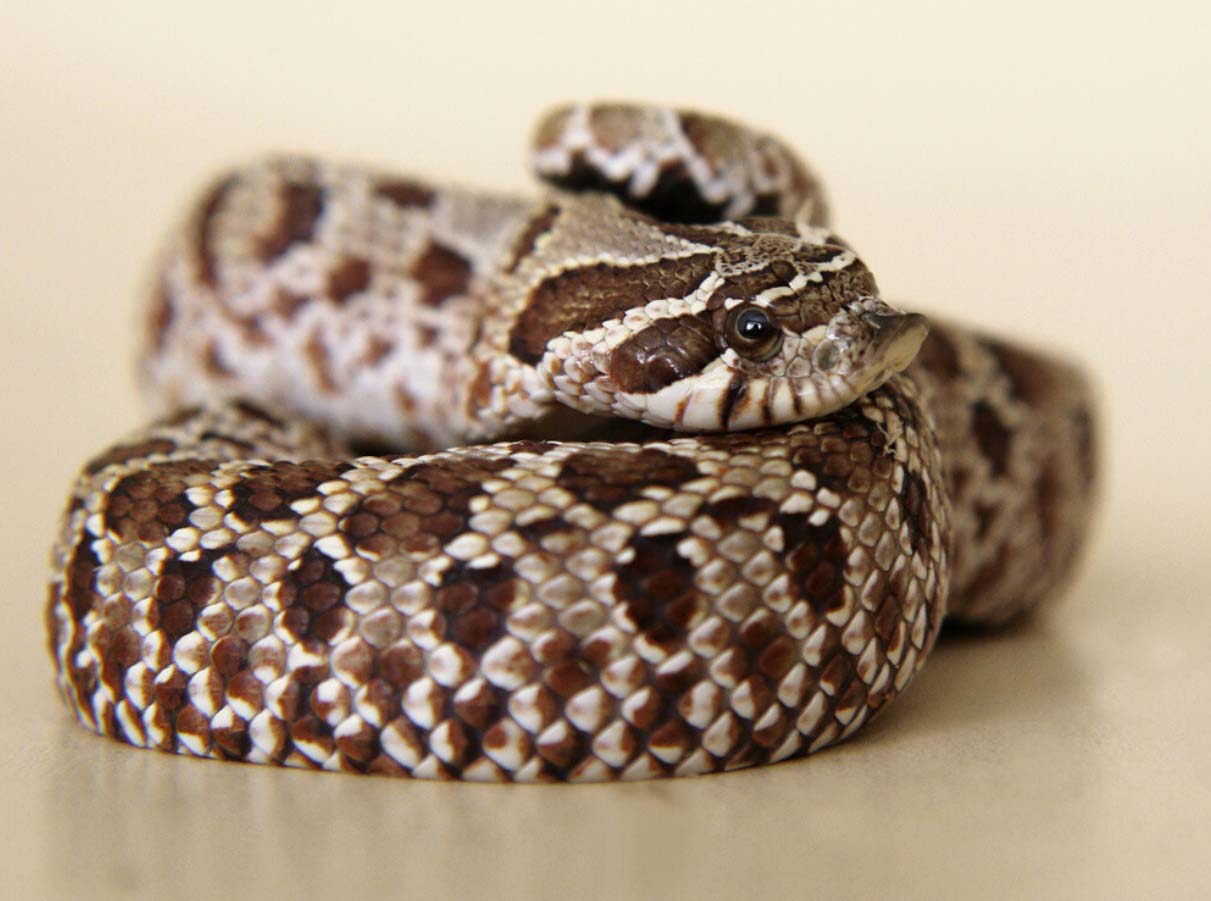Hognose snakes are quickly growing in popularity. Their beautiful looks, easy temperament, and simple care create the perfect combination for beginners and expert keepers alike.
Their unique features and fascinating behaviors make them even more attractive. Add to the fact that they enjoy being handled, and it’s a wonder these snakes are touted as the perfect reptile for newcomers.
| Common Name: | Western Hognose Snake, Plains Hognose Snake |
| Scientific Name: | Heterodon nasicus |
| Natural Habitat: | North America (southern Canada, central U.S., & northern Mexico) |
| Adult Size: | Females grow up to 3 ft.; males grow up to 2 ft. |
| Lifespan: | Up to 18 years in captivity |
| Diet: | Small rodents, lizards, and amphibians; eggs from ground-dwellers |
| Experience Level: | Beginner |
| Enclosure Size: | 10 gallons for hatchlings & juveniles, 20 gallons for adults |
Reptile Overview
Western hognose snakes are small, friendly, and hardy. They can live almost two decades if they’re properly taken care of.
This keeled snake originates from sandy, arid regions where it burrows most of the time.
Despite more recent color morphs, it originally featured neutral colors to help it blend in.
Hognoses are docile and tolerate frequent handling well. However, they do display defensive behaviors when irritated or threatened.
A 20-gallon tank with a thick substrate and minimal décor works well. They need steady access to water and feedings once or twice weekly.
Owners should ensure the tank setup meets the hognose’s heating and humidity needs.
Hognose snakes are not prone to health issues. Despite this, they can suffer from illnesses common to reptiles.
If they’re a morph, hognoses may suffer from additional, breeding-related health issues.
Appearance
Hognose snakes are a smaller, stockier variety of colubrid.
Originating in North America, they have adapted to dry, arid regions.
Their bodies have keeled scales. Instead of laying smooth and interlocking, these scales are ridged and rough.
Their nose is also more pronounced and upturned. Along with their scales, these two features help the hognose move through the substrate quickly and easily.
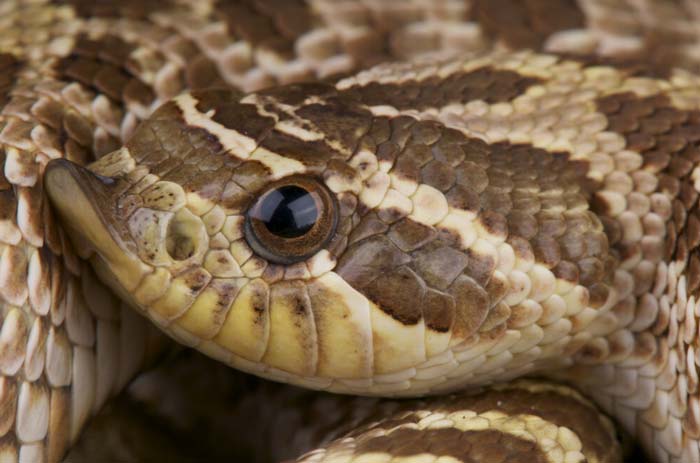
This snout is also adapted for digging, either to begin burrowing or when looking for prey. When necessary, it also helps hognose snakes defend themselves.
Females are larger than males. Females may grow up to three feet, whereas males only grow up to two feet.
Originally, these snakes had a coloring that helped them blend in with the sandy regions they inhabited.
Their natural coloring shows a tan, brown, gray, or olive base color.
This is interspersed with parallel rows of darker spots or bars. These run longitudinally down their body, from their head to the tip of their tail.
Many other color varieties have appeared since they’ve become commercially popular as pets. Hognoses are now available in pastel, albino, axanthic, and other color variations.
Some varieties maintain the original hognose patterns (i.e., parallel spots), while others change or erase it entirely. For example, albino varieties may be completely tan or white.
Behavior & Temperament
Western hognose snakes are docile and easy to handle. If properly done, they don’t mind frequent interaction.
Because of this, they make good snakes for both beginners and experienced keepers.
One of their most fascinating behaviors is their burrowing. Using their specially designed noses, they will dig into the substrate and move around.
They’ll actually spend most of their time underground. If you have a glass or otherwise transparent tank, you might be able to see them burrowing.
Hognoses are diurnal, meaning they’re most active during the day. But this doesn’t mean that they won’t take naps through the day or be awake at night.
They prefer to be fed and handled during the day.
You should handle them at least once per week. This promotes a strong bond and socialization skills.
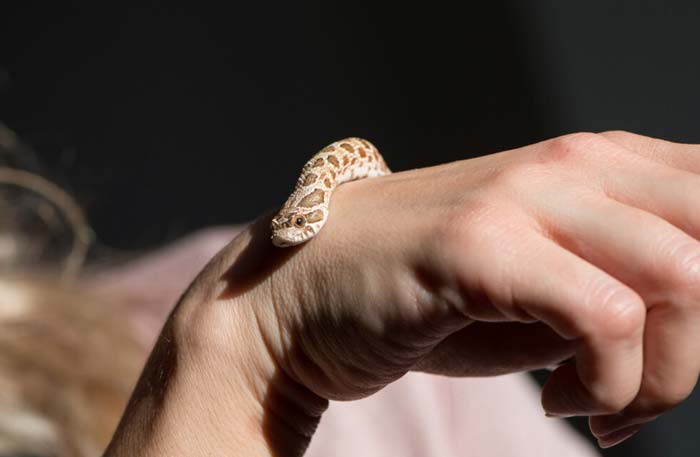
When handling, don’t reach for their head. Instead, focus on the middle or upper third of their body.
Slide your hand under them, providing lots of support. Then, slowly lift them.
In case they’re burrowing, wait until they come to the surface or gently excavate them.
If your snake doesn’t want to be handled, they’ll let you know through defensive behaviors. These are discussed in more detail in the section below.
Depending on your hognose’s color variation, it may display behaviors that are abnormal to the breed. Wobbling is one of the most common examples of this.
Such behaviors are a result of health issues relating to breeding. Skip to the “Potential Heath Issues” section to learn more.
Defensive Behaviors
When threatened, the hognose snake has a variety of defensive behaviors it uses.
These include:
- Hissing
- Flattening its body
- Hooding
- Playing dead
- Striking
For the most part, these behaviors are harmless.
Though seeing these behaviors may scare you, you aren’t in any real danger.
Note that biting is not on this list. Though a hognose snake will strike at you if it feels threatened, their mouth will always be closed.
These snakes actually use their snout, which is heavily keeled, more than their fangs. They will likely strike multiple times, either directly at you or with sideways movements.
The rare times’ owners report real bites usually are connected to improper feeding practices.
If your hognose bites you, don’t panic. They are not venomous.
They produce a proto-lipase enzyme in their saliva, but this is effectively harmless. This enzyme is found in many animals’ saliva.
Your snake may release you shortly after biting. If they don’t, pour a small amount of mint mouthwash on your hand.
This will encourage them to let you, but won’t hurt them.
Never try to yank your hand out of their mouth. This will harm you and your hognose.
Expert Tip: Much like skunks, hognose snakes can also spray you with some pretty foul-smelling musk. But unlike skunks, it doesn’t come off very easily— you’ll need more than tomato juice or baking soda to get rid of this stuff.
If you see your hognose snake displaying these behaviors often, it’s likely a result of stress.
Some defensive behavior is normal, but it shouldn’t be happening on a regular basis.
If your snake is using any of these defensive maneuvers, leave them alone. Wait until they’re calm again before trying to handle, feed, or otherwise interact with them.
Trying to interact with your hognose while it’s defensive will only agitate it further.
Lifespan
The western hognose snake can live up to 18 years in captivity under the right conditions.
To ensure your snake lives a long, happy life, make sure to follow correct dietary recommendations, enclosure setup, etc.
Enclosure
As an infant and juvenile, hognoses are fine in five- or ten-gallon setups. As an adult, you’ll have to upgrade them to 20- or 30-gallon setups.
Tanks, terrariums, tubs, and rack systems will all work. Whichever you choose, keep in mind that your snake will need ventilation.
Additionally, the hognose snake is ground-dwelling. This means that it’s better to have a long enclosure versus a tall enclosure.
This snake isn’t an escape artist like some other species, but you should still make sure the enclosure is secure.
Remember, this is for one individual hognose snake. You can’t stick two or three of them in a 20-gallon tank.
You won’t need a lot of décors. A water bowl and two or three hiding spots will be enough to make your snake happy.
These snakes prefer to burrow, so keep that in mind. The water bowl and hide boxes should be sturdy, but not heavy enough to collapse a tunnel or crush your hognose.
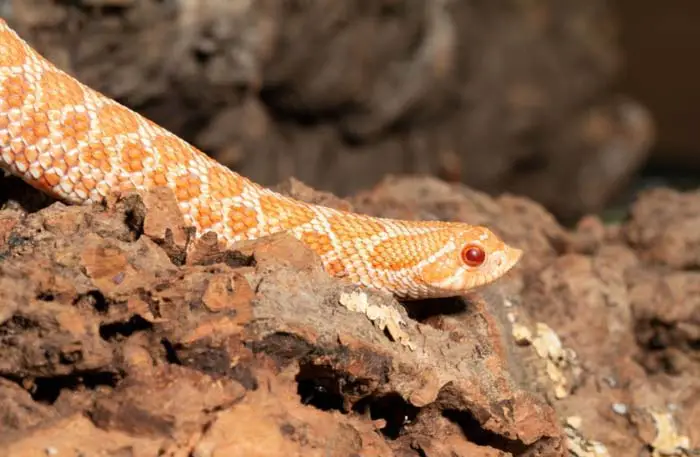
The hide boxes should be dispersed throughout the tank. This is so that your snake has hiding options on both sides of the temperature gradient.
One should be on the ‘hot’ side, another should be on the ‘cool’ side, and the humidity hide should be in the middle.
Expert Tip: Though the humidity hide should be roughly in the middle, it’s better to have it closer to the ‘hot’ side. High humidity + cool air = respiratory illness waiting to happen.
The best substrate depends on your snake’s age.
Hatchlings do best with newspaper. It’s inexpensive and easy to clean.
As a juvenile and adult, aspen bedding is better. It allows them to burrow and is also easy to clean.
We recommend to use natural aspen bedding from Galapagos. It’s great for all burying snakes. And the most important thing that it’s dust-free!
Galapagos Aspen Digs Shavings Bedding
Never use cedar or pine bedding. These types of bedding are dangerous for a snake’s respiratory system.
You should also avoid sand and loose soils. If ingested, these can cause impaction and other health hazards.
Bioactive setups are an exception to this but will need modification.
If you want to do a bioactive setup that mimics their natural habitat, then you’ll be using sand, soil, and similar substrates.
To avoid impaction, you’ll need to add a feeding area with a different substrate. Alternatively, you can use a shallow bowl or other dishware for feeding.
Temperature & Lighting
Western hognose snakes need a temperature spectrum of 95 – 75°F.
Their basking zone should be warmest, around 90 – 95°F. The rest of the tank should range from 90°F on the ‘warm’ side to 75°F on the ‘cool’ side.
At night, these temperatures can drop by 5 – 10°F, but should go no lower than 70°F in the coldest area.
Using two thermometers, one on each side of the tank is an easy way to keep track of this.
Zoo Med Labs Digital Hygrometer and Thermometer
These snakes need full spectrum lighting for at least 10 hours each day. During the warmer months in spring and summer, this should be bumped up to anywhere from 14 to 16 hours each day.
This mimics a snake’s natural day-night cycle.
Night bulbs come in a variety of colors, but blue or purple are best. This is because there is some evidence to suggest that reptiles can see red light.
As a result, using red light doesn’t accurately recreate a night environment. It would be similar to you leaving the lights on all the time, even when you go to bed.
Besides providing general heat, there are also basking bulbs available.
If you use these, make sure the basking area is large. When curled up, your snake should be able to fit in the basking area.
All bulbs should be placed at least six inches away from your reptile. Any closer and they may cause accidental burns.
Additionally, lights should always be placed overhead. Eyebrow ridges and upper eyelids shade reptiles’ eyes from direct sunlight.
But these protective measures don’t work against the light coming from the sides or bottom of a tank.
Automatic timers like Zilla Digital Timer, can turn the lights on and off if you’re worried about keeping this schedule. These are also useful if you work long hours, go on vacation, etc.
Combined with lights, under tank (UT) heaters help maintain the proper temperature.
For this purpose we are using VIVOSUN Reptile Heating Pad with digital thermostat. It’s controlled by a thermostat so you can control temperature in enclosure using digital thermostat.
VIVOSUN Reptile Heating Pad with Digital Thermostat
UT heaters shouldn’t be bigger than one-third of the tank. They should be placed on the outside of the enclosure, either on the bottom or side.
If placed on the bottom, make sure the tank is slightly raised. This allows for air ventilation and prevents overheating.
Since hognose snakes like to burrow, you’ll also need to prevent them from burning themselves. Direct contact with the glass the UT heater is pressed against can accidentally burn your snake.
To avoid this, use a reptile carpet, a towel, mesh guard, or another material. It should be able to transfer and hold heat, but still, protect your snake.
Place the material inside the tank over the same area that the UT heater covers.
If you’re using a rack system, heat tape can be used in place of UT heaters.
Never use heat rocks. There’s no way for you to regulate the temperature on these and they can severely burn your hognose.
Humidity
Western hognose snakes are used to arid regions with lower humidity. Keeping your tank within a 30 – 50% range will keep them comfortable.
Placing the water bowl on the ‘cool’ side of the tank will help with excess humidity. You should also keep it out of the direct path of lights or basking bulbs, if possible.
If your tank needs a quick humidity boost, a pressure sprayer is an easy way to provide it.
Sphagnum moss is also an easy way to add humidity, although it works better in small, enclosed spaces. This type of moss is the preferred substrate for humid hides.
Galápagos Terrarium Sphagnum Moss
Diet
Western hognose snakes can eat a variety of foods, including:
- Small rodents
- Lizards
- Amphibians
- Animal eggs
However, owners by and large prefer small rodents. These are available live or frozen.
There is some debate about whether live rodents cause snakes to be more aggressive. However, no definitive evidence is available.
Live rodents usually entice picky eaters more than thawed rodents. But they are also harder to keep and may injure your snake.
Thawed rodents may not be as appetizing to your hognose. Even so, they last a long time in the freezer and make digestion easier.
There’s also no risk of the rodent fighting back and hurting your hognose.
If you choose pre-killed, frozen rodents, warm them up to at least room temperature. Hognoses usually like them a little warmer.
Hognose are also more prone to eat if you wiggle the mouse or rat around a bit.
This mimics a live rodent without dealing with any of the risks.
Whatever you feed your hognose, the meal should be no larger than your snake’s head.
Feeding once or twice per week works best. Your snake’s appetite and the size of the prey will determine how often they eat.
Hognose snakes will strike at prey from all angles instead of just head-on. Because of this, you should take care to use tongs, forceps, or another feeding device.
unlumm Feeding Tongs 15″ 2 Pcs
Never feed a hognose using your hands.
After eating, your snake should have a bump. It’s normal for their belly to be slightly distended.
However, their stomach should not still be sticking out more than 24 hours later. If it is, try a smaller prey for the next meal.
If you’re still looking into breeders or don’t yet have your hognose, ask about their eating habits.
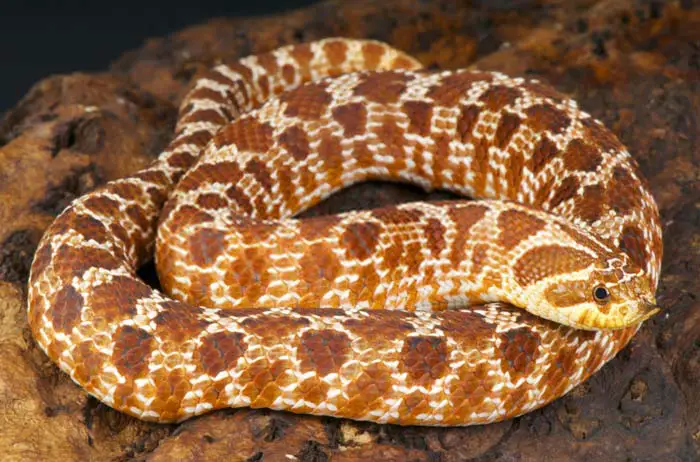
Hognose snakes aren’t known for being picky, so juveniles should take food as readily as adults. If possible, ask for a demonstration or a video of their last feeding.
Usually, the only time owners may struggle to get hognoses to eat is when they’re hatchlings.
If your snake is reluctant to eat at any age, you can try ‘braining’ the rodent. This means poking a hole in the rodent’s skull with a pin and squeezing some of the brain out.
Though not for the squeamish, this method makes the rodent smell more appealing.
You can also try scenting the prey with canned tuna or salmon juice.
However, you’ll need to wean them off this method once they become established eaters. Otherwise, you’ll always have to scent their food.
Potential Health Issues
One of the most common health issues for snakes is mites. These tiny black parasites are annoying for your snake and even more annoying to get rid of.
If you notice your hognose rubbing against décor, soaking for prolonged periods, or acting lethargic, check for mites. They’ll present as tiny dots around the eyes, ears, vent, and shed skin.
Respiratory infections are another concern.
Symptoms include bubbly or stringy saliva, a loss of appetite, and lethargic behavior. Their breathing will also be labored and make a whistling or rattling noise.
If you feed your hognose amphibians or bought a wild-caught specimen, watch out for internal parasites. These are marked by a loss of appetite or regurgitation, weight loss, diarrhea, and foul-smelling poop.
Morphs may also suffer from breeding-related health issues. Though most common in ball pythons, all varieties of morphs may suffer from these genetic problems.
More common health issues include wobble and other neurological impediments, hatching and fertility issues, and kinking.
Spider morphs tend to have more serious issues and have trouble thriving under any conditions. Many don’t survive more than a few years after hatching.
If you suspect your hognose is suffering from any of these health issues, contact your veterinarian immediately.
Regular preventative care and vet check-ups can help prevent health issues or catch them before they become serious.
Before purchasing a western hognose snake, call local veterinarians to make sure one of them is licensed to treat reptiles.
Breeding
Just like hognoses are easy to care for, they’re also fairly easy to breed.
The first step is sexing your snakes. The ‘popping’ method is the easiest way to differentiate between males and females.
After their first shed, apply pressure and roll your thumb toward the cloaca. If hemipenes pop up on either side of the cloacal pouch, it’s a male; if nothing pops up, you’ve got a female.
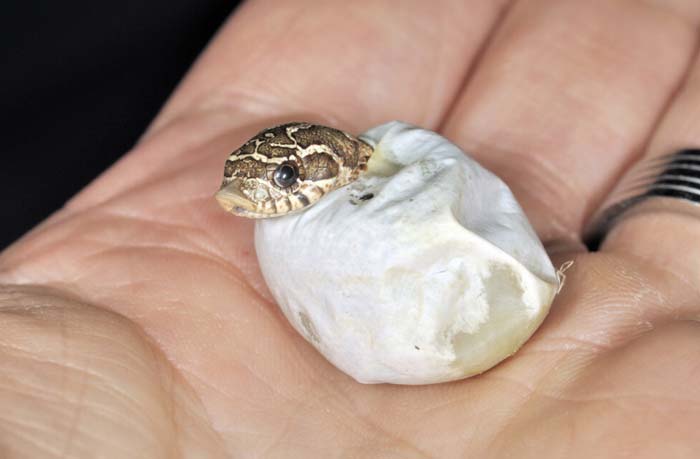
Males should be at least one year and 70 grams (0.15 Ibs) before breeding. Females should be at least two years old and 250 grams (0.5 Ibs).
You’ll need to induce brumation (i.e., hibernation for reptiles). This lasts two to three months, after which point you raise the temperature and begin feeding them again.
Within a month after this, the female should go through an ovulatory shed cycle. After this, she’ll be fertile and ready for breeding.
Look for pronounced swelling in her lower body. When you see this, introduce the male.
Add the male periodically over three days for the best chance at breeding. Alternatively, you can be fairly confident of success if you see the snakes breed at least twice.
Provide a nesting box for your female. It should be warm and humid.
Gestation can take up to 45 days. Pregnant hognoses may continue to eat small meals or become picky; let them control the feeding schedule.
Roughly one to two weeks before laying the eggs, she’ll go through another shed. After this, she’ll likely be restless and active.
However, she should eventually settle into the nesting box and lay the eggs there. Clutches range from eight to 25 eggs or more.
Conclusion
Whether you’re a beginner or an experienced keeper, western hognose snakes are a perfect choice. These beauties are easy to care for, handle, and house.
Their laid-back temperament seems at odds with their more intense appearance. But underneath their keeled exterior is an inquisitive, relaxed reptile.
If you pick a hognose for your next (or first) reptile, you won’t be disappointed. Their captivating behavior and beautiful color variations combine to make a great pet.
Related:

